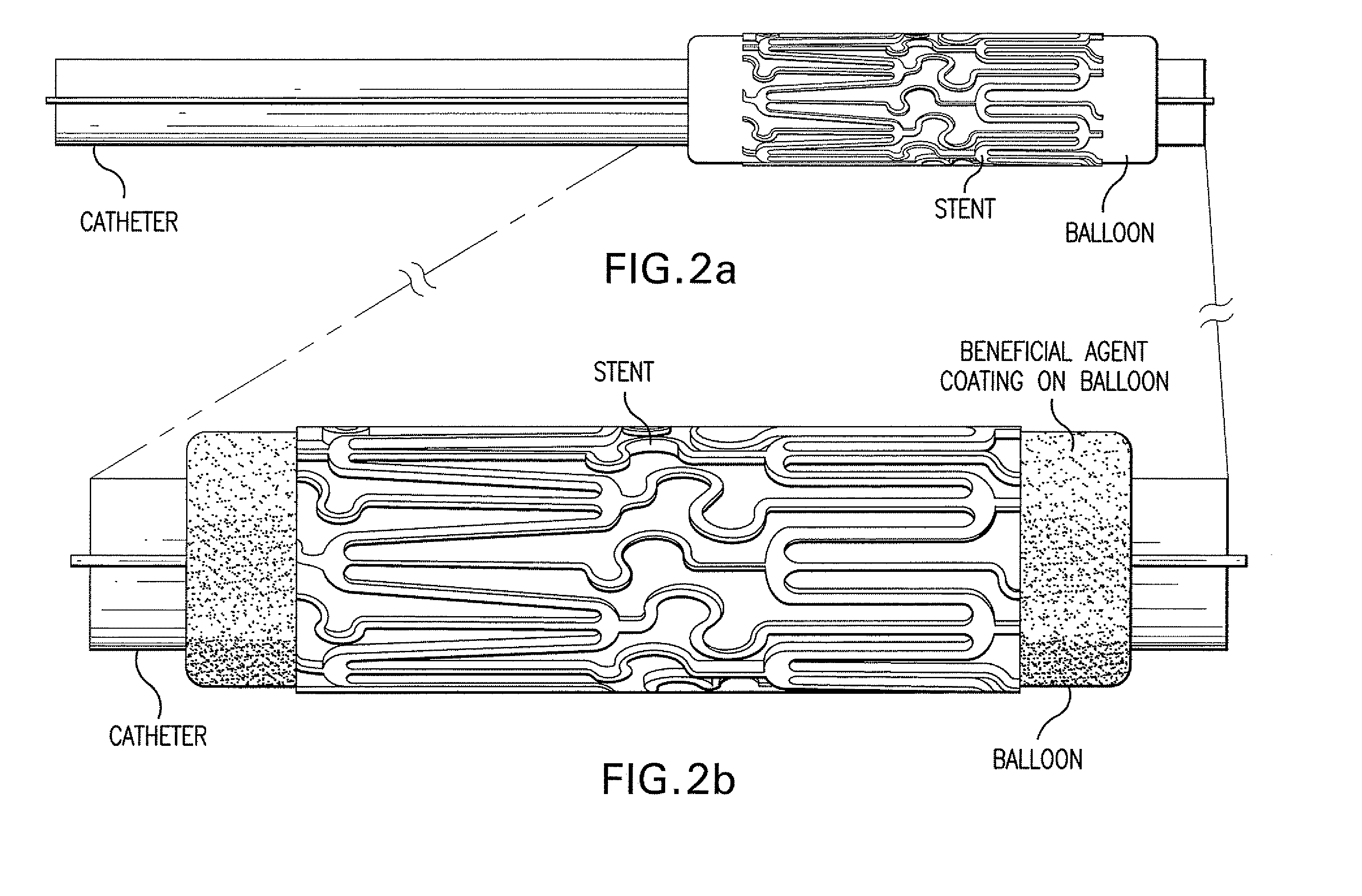Method of treating vascular disease at a bifurcated vessel using a coated balloon
a vascular disease and coated balloon technology, applied in the field of lumen treatment, can solve the problems of a significant rate of restenosis, bare metal stents, and reduced long-term patency of the vessel,
- Summary
- Abstract
- Description
- Claims
- Application Information
AI Technical Summary
Benefits of technology
Problems solved by technology
Method used
Image
Examples
example 1
f Stents with Beneficial Agents or Multiple Beneficial Agents
1. Coating the Stents with PC1036
[0113] Prior to any experimentation, coated stents are prepared. These are 3.0 mm×15 mm 316 L electropolished stainless steel stents. Each stent is spray coated using a filtered 20-mg / mL solution of phosphorylcholine polymer PC1036 (product of Biocompatibles Ltd., Farnham, Surrey, UK) in ethanol. The stents are initially air dried and then cured at 70° C. for 16 hours. They are then sent for gamma irradiation at <25KGy.
II. Loading the Stents with Drugs of Interest
[0114] In these experiments, beneficial agents are loaded onto stents and elution profiles examined. In general, the procedure is as follows. Multiple PC-coated stents are loaded with each of several drugs or combinations thereof from solution, The solutions of the drugs are usually in the range of 2-20 mg / mL of ZOTAROLIMUS (ABT-578) and 10.0 mg / mL dexamethasone in 100% ethanol, with ˜10% PC1036 added to the solution to enhanc...
example 2
f Balloons with Beneficial Agents or Multiple Beneficial Agents
I. Preparing the Balloon for Drug Loading
[0117] Multiple balloons (Jomed 15 mm×3.0 mm) are rolled to minimize the final catheter crossing profile. If needed the balloons where washed in ethanol.
II. Loading the Balloon with Drug of Interest
[0118] In these experiments, beneficial agents are loaded onto balloons. In general, the procedure is as follows. Multiple balloons (Jomed 15 mm×3.0 mm) are loaded with paclitaxel from a solution. The solutions of paclitaxel are usually in the range of 2-20 mg / mL of paclitaxel in 100% ethanol.
[0119] The balloons are weighed before loading with the drug solution. To load approximately 200 to 600 μg of paclitaxel, the balloons are dipped into a solution of paclitaxel. The balloon is removed in a controlled fashion to control drying. The stent is allowed to dry before the balloons are re-weighed to determine total drug load. The loaded, dry balloons are stored at room temperature and...
example 3
of Beneficial Agent-coated Stents onto Beneficial Agent-coated Balloons
[0121] Multiple stents loaded with ZOTAROLIMUS (ABT-578) and top coated with PC1036 are placed over the end of catheter balloons which have been coated with paclitaxel. The stent is centered over the radiopaque markers of the balloon and crimped onto the balloon using a Machine Solutions drug eluting stent crimper. The stent-balloon final product is then leak-tested and visually inspected to ensure the quality of the final product. The catheter assembly is then packaged in Tyvek pouches, labeled, and ETO sterilized.
PUM
| Property | Measurement | Unit |
|---|---|---|
| diameter | aaaaa | aaaaa |
| concentrations | aaaaa | aaaaa |
| time | aaaaa | aaaaa |
Abstract
Description
Claims
Application Information
 Login to View More
Login to View More - R&D
- Intellectual Property
- Life Sciences
- Materials
- Tech Scout
- Unparalleled Data Quality
- Higher Quality Content
- 60% Fewer Hallucinations
Browse by: Latest US Patents, China's latest patents, Technical Efficacy Thesaurus, Application Domain, Technology Topic, Popular Technical Reports.
© 2025 PatSnap. All rights reserved.Legal|Privacy policy|Modern Slavery Act Transparency Statement|Sitemap|About US| Contact US: help@patsnap.com



